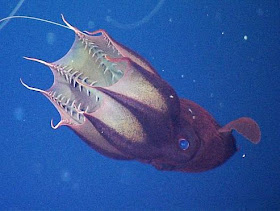Abstract
Vampire squid (Vampyroteuthis infernalis) are considered phylogenetic relics with cephalopod features of both octopods and squids. They lack feeding tentacles, but in addition to their eight arms, they have two retractile filaments, the exact functions of which have puzzled scientists for years. We present the results of investigations on the feeding ecology and behaviour of Vampyroteuthis, which include extensive in situ, deep-sea video recordings from MBARI's remotely operated vehicles (ROVs), laboratory feeding experiments, diet studies and morphological examinations of the retractile filaments, the arm suckers and cirri. Vampire squid were found to feed on detrital matter of various sizes, from small particles to larger marine aggregates. Ingested items included the remains of gelatinous zooplankton, discarded larvacean houses, crustacean remains, diatoms and faecal pellets. Both ROV observations and laboratory experiments led to the conclusion that vampire squid use their retractile filaments for the capture of food, supporting the hypothesis that the filaments are homologous to cephalopod arms. Vampyroteuthis' feeding behaviour is unlike any other cephalopod, and reveals a unique adaptation that allows these animals to spend most of their life at depths where oxygen concentrations are very low, but where predators are few and typical cephalopod food is scarce.
Keywords: Vampyroteuthis infernalis, cephalopoda, oxygen minimum zone, detritus feeding
Figure 1. (a) A juvenile Vampyroteuthis with its filament extended, the short peduncle is visible at the base of the filament. (b) A vampire squid with a retrieved filament and the web partly curled, revealing the arms and cirri. (c) Oral view into the vampire squid's web showing the arms with cirri and the suckers present on the distal half of the arm.
Figure 4: (a) An oral view of Vampyroteuthis infernalis. (b) A marine aggregate in the mouth of vampire squid. (c) A dorso-lateral close-up of the left side of the head of a vampire squid, showing the filament being retracted, a mucus trail is visible on the filament. (d) An oral view of a vampire squid showing a trail of mucus with associated food particles running to the mouth. (e) A vampire squid with a forward-extended filament and a piece of marine snow on the tip of the second right arm. (f) The same specimen shown in (e) now retrieving the filament along the tips of its arms.
'Squid from hell' secrets revealed
| The vampire squid's mouth opens up like an umbrella.
Biologists say they have unlocked secrets about the vampire squid, a mysterious creature that feeds on the decaying dead in the unlit depths.
The vampire squid Vampyroteuthis infernalis's mouth opens up like an umbrella.
Hendrik J. T. Hoving and Bruce H. Robison. Vampire squid: detritivores in the oxygen minimum zone. Proc. R. Soc. B, September 26, 2012 DOI: http://dx.doi.org/10.1098/rspb.2012.1357





